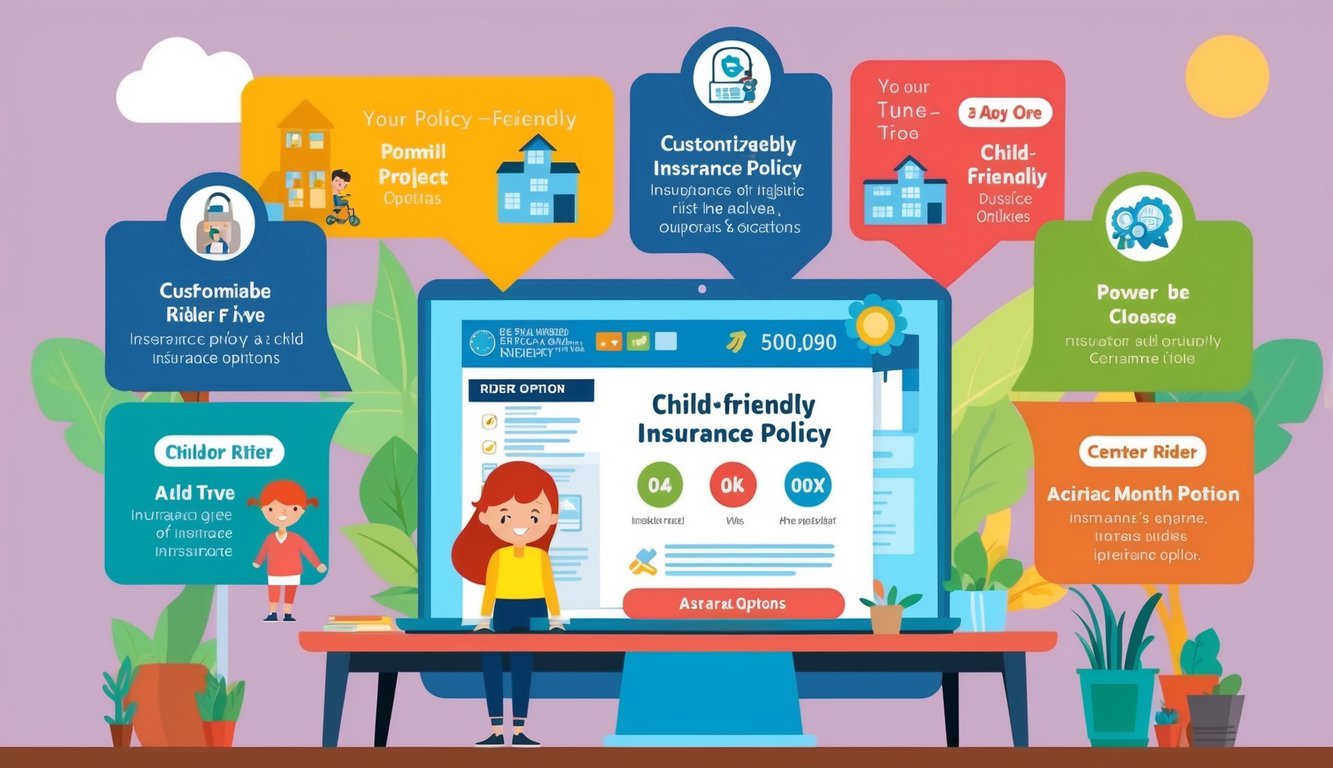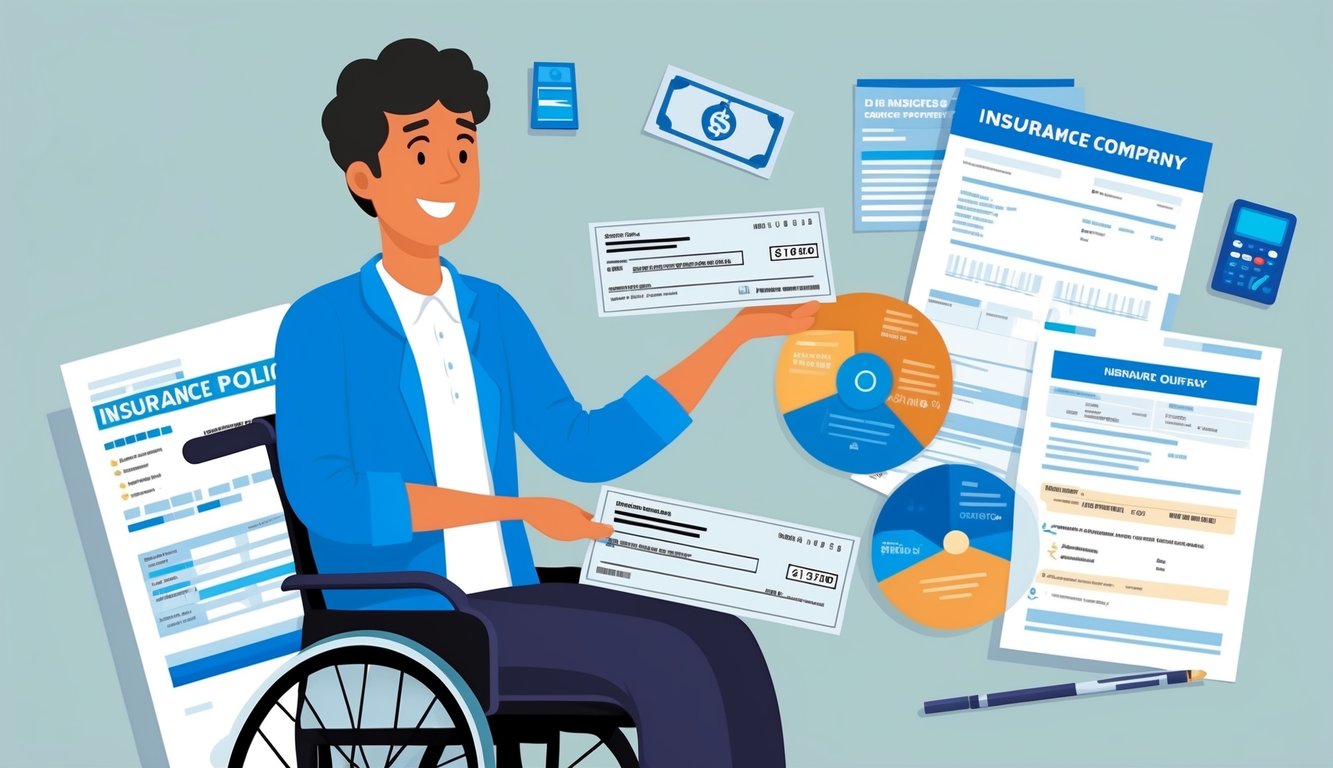Insurance policies can be complex financial products designed to protect you and your loved ones.
While standard policies offer broad coverage, they may not address all your unique needs and circumstances.
Insurance riders allow you to customize your policy by adding specific benefits or coverage options. These add-ons can enhance your protection and provide peace of mind in various situations.
By understanding how riders work and which ones are available, you can tailor your insurance to better suit your individual requirements and potential risks.
1) Accidental Death Benefit Rider
An accidental death benefit rider is an optional add-on to your life insurance policy.
It provides an additional payout if you die due to an accident, on top of your policy’s regular death benefit.
This rider typically doubles the death benefit amount if your death is caused by accidental means.
For example, if you have a $500,000 life insurance policy with this rider, your beneficiaries could receive up to $1,000,000 if you die in a covered accident.
Accidental death riders are available for both term and whole life insurance policies.
You can usually add this rider when you first purchase your policy or during policy renewals.
The cost of this rider varies but is generally affordable compared to the potential benefit.
It’s often calculated as a percentage of your base policy premium.
There are some limitations to be aware of. Most accidental death riders terminate at age 70, or the benefit may be reduced after this age.
Additionally, not all types of accidents are covered, so it’s crucial to read the terms carefully.
This rider can be particularly valuable if you work in a high-risk occupation or frequently engage in dangerous activities.
It provides extra peace of mind knowing your loved ones will have additional financial protection if something unexpected happens to you.
2) Waiver of Premium Rider
A waiver of premium rider is a valuable addition to your life insurance policy.
This rider waives premium payments if you become critically ill, seriously injured, or physically impaired.
The rider typically activates if you’re disabled for six months or more.
During this time, your policy remains in force without you having to pay premiums.
This feature ensures your life insurance coverage continues even when you’re unable to work.
It provides peace of mind, knowing your beneficiaries will still receive the death benefit if something happens to you during this period.
The cost of a waiver of premium rider varies.
It may increase your premiums by 10% to 25%, depending on factors like your age, health, and coverage amount.
To qualify for this rider, you’ll likely need to meet certain age and health requirements.
Many insurers offer it to policyholders under 60 or 65 years old.
It’s important to carefully review the terms of the waiver of premium rider.
Each insurer may have different definitions of disability and waiting periods before the waiver takes effect.
Remember, this rider only covers the base policy premium.
If you have other riders, you may need to continue paying for those separately.
Consider your financial situation and risk factors when deciding if a waiver of premium rider is right for you.
It can be particularly beneficial if you rely heavily on your income to pay premiums.
3) Guaranteed Insurability Rider
A guaranteed insurability rider allows you to increase your life insurance coverage without undergoing additional medical exams or answering health questions.
This rider provides flexibility to adapt your policy as your needs change over time.
You can typically exercise this option at specific intervals or life events, such as marriage, having a child, or reaching certain ages.
The option periods usually end around age 40, but this can vary depending on the insurer.
Adding this rider to your policy comes with an extra cost.
However, it can be valuable if you anticipate needing more coverage in the future and want to avoid potential health issues affecting your insurability.
One advantage is that your premium rates for the additional coverage are based on your age and health status when you first purchased the policy.
This can result in significant savings compared to buying a new policy later in life.
Keep in mind that there may be limits on how much you can increase your coverage each time you exercise the option.
Additionally, the rider might have an expiration date or a maximum number of times you can use it.
Consider adding a guaranteed insurability rider if you expect major life changes or if you’re concerned about future health issues affecting your ability to obtain additional coverage.
It provides peace of mind and financial flexibility as your insurance needs evolve.
4) Family Income Benefit Rider
A family income benefit rider is an optional add-on to your life insurance policy.
It provides a steady stream of income to your beneficiaries if you pass away during the policy term.
With this rider, your beneficiaries receive monthly payments instead of a lump sum.
The payments typically last for a predetermined period or until the end of the policy term.
The family income rider aims to replace your income and help your family maintain their standard of living.
It can cover expenses like mortgage payments, education costs, and daily living needs.
You can customize the rider to fit your family’s needs.
You choose the monthly payout amount and the duration of payments when adding the rider to your policy.
The cost of a family income benefit rider depends on factors like your age, health, and the coverage amount.
It will increase your premium payments, so consider if it fits your budget.
This rider can provide peace of mind, knowing your family will have consistent financial support.
It may be particularly beneficial if you’re the primary breadwinner or have young children.
When considering this rider, evaluate your family’s long-term financial needs.
Think about how long they might need income support and what expenses they’ll need to cover.
Remember that the total payout from a family income rider may be less than a lump sum death benefit.
Consider discussing the pros and cons with a financial advisor to determine if it’s right for your situation.
5) Children’s Term Rider

A children’s term rider is an add-on to your life insurance policy that provides coverage for your children.
This rider typically covers all your children under one premium, including future children.
The coverage amount for a child term rider usually ranges from $10,000 to $25,000.
It’s an affordable way to ensure financial protection for your family in the unfortunate event of a child’s death.
You can generally add this rider to your policy for children between 15 days and 18 years old.
The coverage often extends until the child’s 25th birthday or your 65th birthday, whichever comes first.
The cost of a child rider is relatively low.
You can expect to pay about $5 to $7 per $1,000 of coverage annually.
For example, a $10,000 rider might cost you around $60 per year.
One advantage of this rider is its convertibility.
When your child reaches adulthood, you can often convert the rider into a permanent life insurance policy without a medical exam.
Consider adding a children’s term rider if you want an economical way to cover funeral expenses or other costs associated with the loss of a child.
It’s a simple addition that can provide peace of mind for your entire family.
6) Return of Premium Rider

A return of premium rider is an optional add-on to term life insurance policies.
It allows you to reclaim the premiums paid if you outlive your policy term.
This rider can be appealing if you want the security of life insurance but are hesitant about potentially “wasting” money on premiums.
With this rider, you can get your premiums back if you survive the policy term.
Adding a return of premium rider increases your policy cost.
The extra amount you pay is essentially an investment in getting your money back later.
It’s important to note that this rider typically only refunds base premiums.
Additional costs for other riders or fees may not be included in the refund.
The refund is usually tax-free, as it’s considered a return of your own money rather than income.
This can be a significant financial benefit when the policy term ends.
Some policies offer partial refunds if you cancel early, but the amount returned typically increases the longer you keep the policy. Full premium returns are generally only available if you maintain the policy for the entire term.
Consider your financial goals and risk tolerance when deciding if this rider is right for you.
While it provides a safety net, the higher premiums could potentially be invested elsewhere for potentially greater returns.
7) Long-Term Care Rider

A long-term care rider is an add-on to your life insurance policy that can provide financial support if you need extended care.
This rider allows you to access a portion of your death benefit while you’re still alive to cover long-term care expenses.
With a long-term care rider, you typically can use 1% to 4% of your policy’s death benefit per month for care costs.
This can help pay for nursing homes, assisted living facilities, or in-home care services.
The amount available for long-term care is usually limited to 70% to 80% of the total death benefit.
When you apply for the rider, you’ll choose the percentage you want to receive monthly if needed.
Adding this rider to your policy will increase your premiums.
The cost varies by insurer but may add $600 to $800 to your annual premiums.
While this is an additional expense, it’s often more affordable than purchasing a separate long-term care insurance policy.
If you never use the long-term care benefits, your beneficiaries will still receive the full death benefit.
This makes a long-term care rider an attractive option for those who want protection against potential care costs without losing their life insurance coverage.
Before adding this rider, consider your health, family history, and financial situation.
It’s a valuable tool for customizing your policy to meet your specific needs and concerns about future care expenses.
8) Critical Illness Rider

A critical illness rider is an optional add-on to your life insurance policy that provides financial protection if you’re diagnosed with a severe medical condition.
This rider can offer peace of mind and financial support during challenging times.
Critical illness riders typically cover conditions such as heart attack, cancer, stroke, kidney failure, and ALS.
If you’re diagnosed with a covered illness, you can receive a portion of your death benefit while you’re still alive.
This advance payment can help cover medical expenses, lost income, or other financial needs that arise due to your illness.
It’s important to note that using this benefit will reduce the overall death benefit your beneficiaries receive.
The cost of adding a critical illness rider varies depending on factors like your age, health, and the amount of coverage you choose.
It’s generally more affordable to add this rider when you’re younger and healthier.
When considering a critical illness rider, carefully review the covered conditions and payout terms.
Each insurer may have different definitions and requirements for qualifying illnesses.
Adding this rider to your policy can provide an extra layer of financial security.
It allows you to customize your coverage to better suit your needs and concerns.
Remember that a critical illness rider is not a substitute for comprehensive health insurance.
It’s designed to complement your existing coverage and provide additional financial support during a health crisis.
9) Disability Income Rider

A disability income rider is an optional add-on to your life insurance policy that provides financial protection if you become disabled and unable to work.
This rider can help replace a portion of your lost income during the period of disability.
If you become disabled, the disability income rider typically pays out a monthly benefit.
The amount is usually a percentage of your policy’s face value or your regular income.
The benefit period can vary, ranging from a few months to several years or even until retirement age.
You’ll need to check the specific terms of the rider to understand the duration of coverage.
To qualify for benefits, you generally need to meet the policy’s definition of disability.
This often involves being unable to perform the duties of your regular occupation due to illness or injury.
Adding a disability income rider to your life insurance policy can customize your coverage to better suit your needs.
It provides an extra layer of financial security beyond the death benefit.
Keep in mind that premiums for this rider will increase the overall cost of your insurance policy.
You’ll need to weigh the additional expense against the potential benefits it offers.
Some policies may have a waiting period before benefits begin.
This is often called the elimination period.
It’s important to understand this timeframe when considering the rider.
Remember that a disability income rider is different from standalone disability insurance.
It’s designed to supplement your coverage, not replace a comprehensive disability policy.
10) Cost of Living Rider

A cost-of-living rider is an optional add-on to your life insurance policy.
It helps protect your death benefit against inflation over time.
With this rider, your policy’s death benefit increases automatically at regular intervals.
The increase is typically based on a standard measure of inflation, such as the Consumer Price Index.
You don’t need to undergo additional medical exams or provide new health information for these increases.
The rider ensures your death benefit keeps pace with rising costs.
Adding a cost-of-living rider to your policy comes at an extra cost.
Your premiums will be higher than for a standard policy without this feature.
The rider is particularly beneficial if you’re buying life insurance at a young age.
It helps maintain the purchasing power of your death benefit over a long period.
Some insurers may cap the total increase allowed under this rider.
Others might offer it only for certain types of policies, such as term or whole life insurance.
Consider your long-term financial goals and budget when deciding if this rider is right for you.
It can provide valuable protection against inflation, but the increased premiums may not fit everyone’s budget.
Understanding Insurance Riders
Insurance riders allow you to customize your policy to fit your specific needs.
These optional add-ons enhance coverage and provide additional benefits beyond the standard policy.
Definition of Insurance Riders
Insurance riders are additional features or benefits that you can attach to your existing insurance policy.
They modify or expand your coverage to address particular concerns or situations you may face.
Riders give you flexibility to tailor your insurance protection without purchasing an entirely new policy.
You can add riders when you first buy insurance or often later on as your needs change.
Most riders come at an extra cost, typically increasing your premium.
However, some insurance companies may include certain riders at no additional charge as part of their standard offerings.
Types of Insurance Riders
There are numerous types of insurance riders available, each designed to address specific needs or scenarios:
Accelerated Death Benefit Rider: This allows you to access a portion of your life insurance death benefit if you’re diagnosed with a terminal illness.
It can help cover medical expenses or other costs during your final months.
Accidental Death Benefit Rider: This rider provides an additional payout if you die due to an accident.
It can be added to term or whole life policies, often without requiring a medical exam.
Long-Term Care Rider: With this option, you can use part of your life insurance death benefit to pay for long-term care expenses if needed.
It can be a more cost-effective alternative to standalone long-term care insurance.
Waiver of Premium Rider: This rider waives your insurance premiums if you become disabled and unable to work.
It ensures your coverage remains in force even if you can’t afford to pay premiums due to disability.
Benefits of Customizing Your Policy with Riders
Insurance riders offer valuable advantages for policyholders seeking tailored coverage.
They provide flexibility and protection beyond standard policies, addressing specific needs and circumstances.
Increased Coverage
Life insurance riders expand your policy’s scope, offering additional protection for various situations.
You can add coverage for critical illness, disability, or long-term care needs.
This enhanced protection ensures you’re prepared for unexpected life events.
Riders can also extend benefits to family members.
For example, a child rider provides coverage for your children under your policy.
Some riders offer living benefits, allowing you to access a portion of your death benefit if you become terminally ill.
This feature can help cover medical expenses or maintain your quality of life during difficult times.
Cost-Effective Customization
Customizing your insurance policy with riders is often more affordable than purchasing separate policies for each type of coverage.
You can tailor your protection to fit your specific needs without overpaying for unnecessary features.
Riders allow you to adjust your coverage as your life circumstances change.
This flexibility means you can add or remove protection as needed, ensuring your policy remains relevant and cost-effective over time.
Many insurers offer riders at competitive rates, especially when bundled with your main policy.
This approach can result in significant savings compared to standalone policies for each type of coverage.
Steps to Add a Rider to Your Policy
Adding a rider to your insurance policy involves identifying your specific needs and working closely with your insurance provider.
This process ensures your policy is tailored to your unique circumstances.
Identifying Your Needs
Start by assessing your current life situation and potential future risks.
Consider major life events, health concerns, or financial obligations that may require additional coverage.
For example, if you have dependents, you might want to add a child term rider to your life insurance policy.
Make a list of your priorities and concerns.
This will help you focus on the most relevant riders for your situation.
Remember, riders come with additional costs, so prioritize based on your budget and the most critical needs.
Research different types of riders available.
Common options include:
- Accidental death benefit
- Waiver of premium
- Long-term care
- Critical illness
Consulting with Your Insurance Provider
Contact your insurance company to discuss adding a rider to your policy.
Prepare questions about the rider’s cost, coverage limits, and any restrictions or exclusions.
Ask about the application process.
Some riders may require additional medical exams or underwriting.
Your provider can explain the steps involved and any necessary documentation.
Review the terms and conditions of the proposed rider carefully.
Ensure you understand how it affects your existing policy and premiums.
Don’t hesitate to ask for clarification on any points you find confusing.
Once you’ve decided on a rider, complete the required paperwork and submit it to your insurance company.
They will process your request and inform you of the approval status.
Common Mistakes to Avoid
When customizing your insurance policy with riders, it’s crucial to be aware of potential pitfalls.
Being informed and proactive can help you maximize your coverage and avoid costly oversights.
Overlooking Key Riders
Adding riders to your insurance policy can significantly enhance your coverage, but you may leave yourself underprotected if you fail to consider important options.
Don’t overlook riders that address your specific needs and circumstances.
For example, a child term rider could provide valuable coverage for your children if you have dependents.
Similarly, a disability income rider might be crucial if you’re the primary breadwinner.
Review all available riders carefully.
Consult with your insurance agent to understand which ones align with your financial situation and long-term goals.
Some riders are more cost-effective when added at the policy’s inception rather than later.
Be thorough in your initial assessment to avoid missing out on important coverage options.
Not Reviewing Your Policy Regularly
Your insurance needs can change over time, so it’s essential to review your policy and riders periodically.
Life events such as marriage, having children, or changing careers may necessitate adjustments to your coverage.
Set a reminder to review your policy annually.
During this review, consider:
- Changes in your financial situation
- New dependents or responsibilities
- Alterations in your health status
- Shifts in your long-term goals
Be proactive in communicating with your insurance provider about life changes.
They can help you determine if you need to add, modify, or remove riders to keep your policy aligned with your current needs.
Don’t assume your policy will automatically adapt to your changing circumstances.
Regular reviews ensure your coverage remains relevant and comprehensive.






